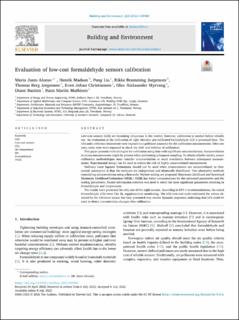| dc.contributor.author | Justo Alonso, Maria | |
| dc.contributor.author | Madsen, Henrik | |
| dc.contributor.author | Liu, Peng | |
| dc.contributor.author | Jørgensen, Rikke Bramming | |
| dc.contributor.author | Jørgensen, Thomas Berg | |
| dc.contributor.author | Christiansen, Even Johan | |
| dc.contributor.author | Myrvang, Olav Aleksander | |
| dc.contributor.author | Bastien, Diane | |
| dc.contributor.author | Mathisen, Hans Martin | |
| dc.date.accessioned | 2022-08-11T06:31:09Z | |
| dc.date.available | 2022-08-11T06:31:09Z | |
| dc.date.created | 2022-08-09T10:12:12Z | |
| dc.date.issued | 2022 | |
| dc.identifier.issn | 0360-1323 | |
| dc.identifier.uri | https://hdl.handle.net/11250/3011189 | |
| dc.description.abstract | Low-cost sensors (LCS) are becoming ubiquitous in the market; however, calibration is needed before reliable use. An evaluation of the calibration of eight identical pre-calibrated formaldehyde LCS is presented here. The LCS and a reference instrument were exposed to a pollutant source(s) for the calibration measurements. After one year, some tests were repeated to check the drift and stability of calibration.
This paper presents methodologies for calibration using data with significant autocorrelations. Autocorrelation in sensor measurements might be present when performing a frequent sampling. To obtain reliable results, sensor calibration methodologies must consider autocorrelation or serial correlation between subsequent measurements. Experimental design can be used to reduce the risk of highly autocorrelated measurement.
Ordinary Least Squares Estimations should not be used when measurements are autocorrelated, as their central assumption is that the residuals are independent and identically distributed. Two alternative methods considering autocorrelation using a first-order Markov scaling are proposed: Maximum Likelihood and Restricted Maximum Likelihood Estimation (REML). REML has better compensations for the estimated parameters and the scaling parameters. Akaike information criterion was used to select the most significant parameters resulting in formaldehyde and temperature.
The results were presented for only one of the eight sensors. According to EPA's recommendations, the tested formaldehyde LCSs were Tier III, supplementary monitoring. The LCS over-and under-estimated the values obtained by the reference sensor, but they presented very similar dynamic responses, indicating that LCS could be used to detect concentration changes after calibration. | en_US |
| dc.language.iso | eng | en_US |
| dc.publisher | Elsevier | en_US |
| dc.rights | CC BY 4.0 | * |
| dc.rights.uri | http://creativecommons.org/licenses/by/4.0/ | * |
| dc.subject | IAQ | en_US |
| dc.subject | Low-cost sensors | en_US |
| dc.subject | RH | en_US |
| dc.subject | Formaldehyde | en_US |
| dc.subject | TVOC | en_US |
| dc.subject | CO2 | en_US |
| dc.subject | Air temperature | en_US |
| dc.title | Evaluation of low-cost formaldehyde sensors calibration | en_US |
| dc.title.alternative | Evaluation of low-cost formaldehyde sensors calibration | en_US |
| dc.type | Peer reviewed | en_US |
| dc.type | Journal article | en_US |
| dc.description.version | publishedVersion | en_US |
| dc.rights.holder | © 2022 The authors | en_US |
| dc.source.volume | 222 | en_US |
| dc.source.journal | Building and Environment | en_US |
| dc.identifier.doi | 10.1016/j.buildenv.2022.109380 | |
| dc.identifier.cristin | 2041887 | |
| dc.relation.project | Norges forskningsråd: 257660 | en_US |
| dc.source.articlenumber | 109380 | en_US |
| cristin.ispublished | true | |
| cristin.fulltext | original | |
| cristin.qualitycode | 2 | |

